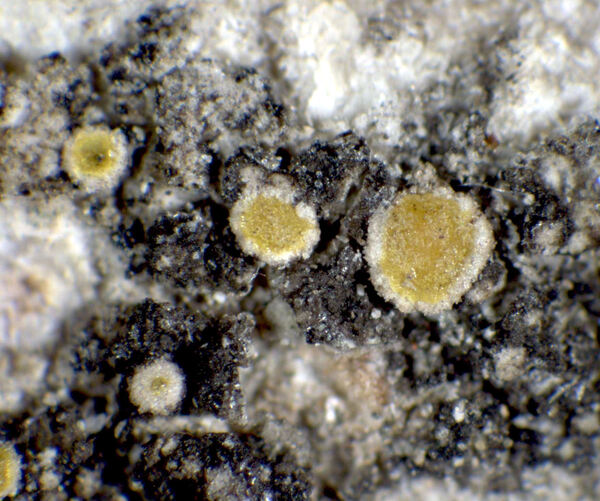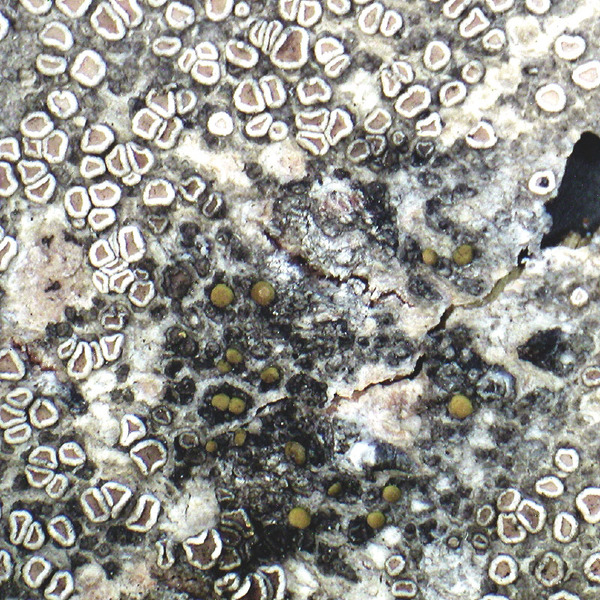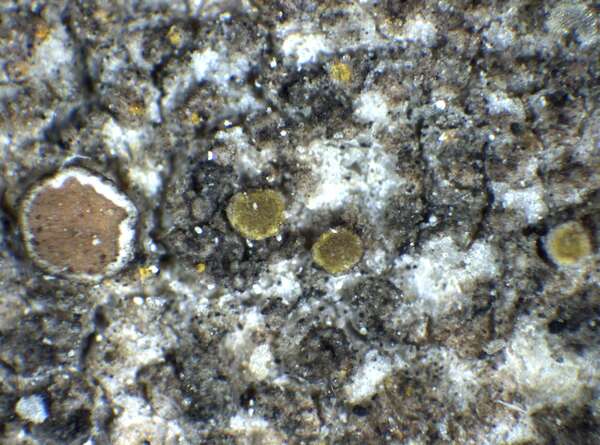Candelariella superdistans (Nyl.) Malme
Svensk Bot. Tidskr., 4: 164, 1910. Basionym: Lecanora superdistans Nyl. - Flora, 62: 355, 1879.
Synonyms:
Distribution: N - Frl. S - Cal (Puntillo 1996).
Description: Thallus mostly inapparent, rarely finely granulose and grey to almost black, growing on the thalli and apothecial margins of Polyozosia populicola. Apothecia lecanorine, small, 0.2-0.8 mm across, with a flat to convex, yellow disc and a thin, concolorous, smooth, finally often excluded margin. Thalline exciple prosoplectenchymatous, with protruding hyphae; epithecium yellow, granular; hymenium colourless, 50-60 µm high; paraphyses mostly simple or sparingly branched in upper part, the apical cells lightly swollen; hypothecium colourless. Asci 8-spored, clavate, with an apical dome which is I+ blue only in the internal, lower part, interrupted in the centre by an I+ paler blue strip, Candelaria-type. Ascospores 1-celled, hyaline, ellipsoid, (12-)13-20(-22) x 5-7 µm. Photobiont chlorococcoid. Spot tests: apothecia K- or K+ reddish-orange, C-, KC-, P-. Chemistry: apothecia with pulvinic acid derivatives.Note: a cool-temperate lichen starting the life-cycle on Polyozosia populicola; overlooked in the past but certainly not common in Italy. It is included in the Italian red list of epiphytic lichens as “Endangered” (Nascimbene & al. 2013c).
Growth form: Crustose
Substrata: bark
Photobiont: green algae other than Trentepohlia
Reproductive strategy: mainly sexual
Most common in areas with a humid-warm climate (e.g. most of Tyrrenian Italy)
paras Lecanora populicola
Commonnes-rarity: (info)
Alpine belt: absent
Subalpine belt: absent
Oromediterranean belt: absent
Montane belt: very rare
Submediterranean belt: absent
Padanian area: absent
Humid submediterranean belt: absent
Humid mediterranean belt: absent
Dry mediterranean belt: absent

Predictive model
Growth form: Crustose
Substrata: bark
Photobiont: green algae other than Trentepohlia
Reproductive strategy: mainly sexual
Most common in areas with a humid-warm climate (e.g. most of Tyrrenian Italy)
paras Lecanora populicola
Commonnes-rarity: (info)
Alpine belt: absent
Subalpine belt: absent
Oromediterranean belt: absent
Montane belt: very rare
Submediterranean belt: absent
Padanian area: absent
Humid submediterranean belt: absent
Humid mediterranean belt: absent
Dry mediterranean belt: absent

Predictive model
 INDEX FUNGORUM
INDEX FUNGORUM
 GBIF
GBIF
 DOLICHENS
DOLICHENS






